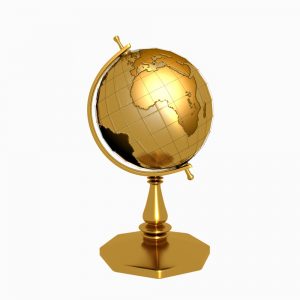

Asia Pacific Visitor Forecasts 2018-2022
Hong Kong SAR the strongest destination in both average percentage growth and additional arrivals received in 2022
BANGKOK, March 1, 2018 – Hong Kong SAR will lead Asia Pacific destinations in terms of growth over the next five years, according to the just released Asia Pacific Visitor Forecasts 2018-2022 Full Report. Following on from the earlier release of the Executive Summary Report, the Full Report delves deeper into origin-destination pairs for 40 Asia Pacific destinations, as well as tourism receipts and income and price elasticities, where data permit.
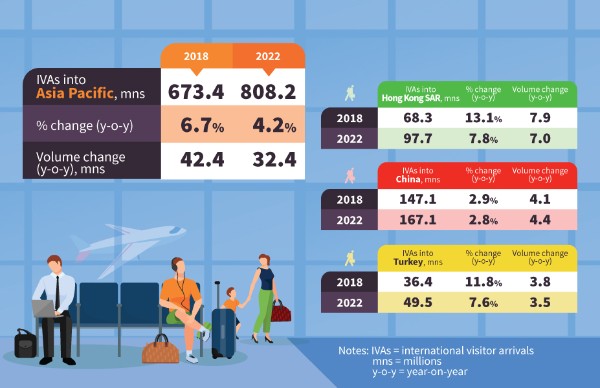
ANNUAL FOREIGN VISITOR GROWTH – 2017 TO 2018
The Asia Pacific destinations covered in this report are forecast to receive an aggregate inbound count of more than 673 million international visitor arrivals in 2018, well in excess of 42 million more than the volume received in 2017. Hong Kong SAR, China and Turkey lead the way with annual increases of 7.9 million, 4.1 million and 3.8 million foreign arrivals respectively.
Destinations in the Americas register highly as well, with the USA and Mexico in particular, expected to show annual increases in inbound foreign arrivals of 3.6 million and 2.6 million respectively.
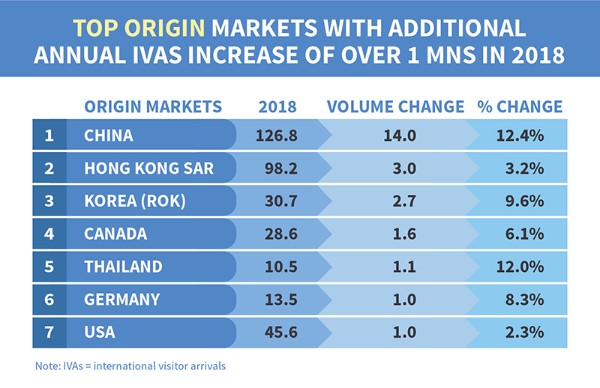
The major international visitor-generating markets will be China, Hong Kong SAR and Korea (ROK) with those three origin markets producing a collective increase of close to 20 million additional IVAs into Asia Pacific between 2017 and 2018. In the Americas, Canada and the USA will generate an additional 2.7 million arrivals. In total, seven origin markets will add volume increases of more than one million foreign arrivals each, from Asia (four origin markets), the Americas (two origin markets) and Europe (one origin market).
Across the arrivals-generating regions, it is expected that Asia will account for 68% of the additional volume received by Asia Pacific destinations between 2017 and 2018; Europe will produce close to 13% and the Americas a little under 11%.
East Europe is expected to produce some solid gains over this period as well, especially out of the Russian Federation and Poland with each of these origin markets producing well over 600,000 additional arrivals each, between 2017 and 2018. Out of the Pacific, Australia will also be a solid producer of foreign arrivals into Asia Pacific, adding more than 780,000 additional arrivals over this period.
PERIOD FOREIGN VISITOR GROWTH – 2017 TO 2022
By 2022, it is expected that China will consolidate its position as the number one destination in Asia Pacific, capturing one-fifth of the total volume of foreign arrivals into the region in that year. Hong Kong SAR and the USA follow in terms of the absolute volume of foreign arrivals in that year, however, China has a lead of more than 64 million over Hong Kong SAR, its closest contender.
Mexico and Turkey make up the top five inbound ranking by absolute volume in 2022 and together, these top five destinations account for well over half (55.5%) of all the foreign visitor arrivals into Asia Pacific in that year.
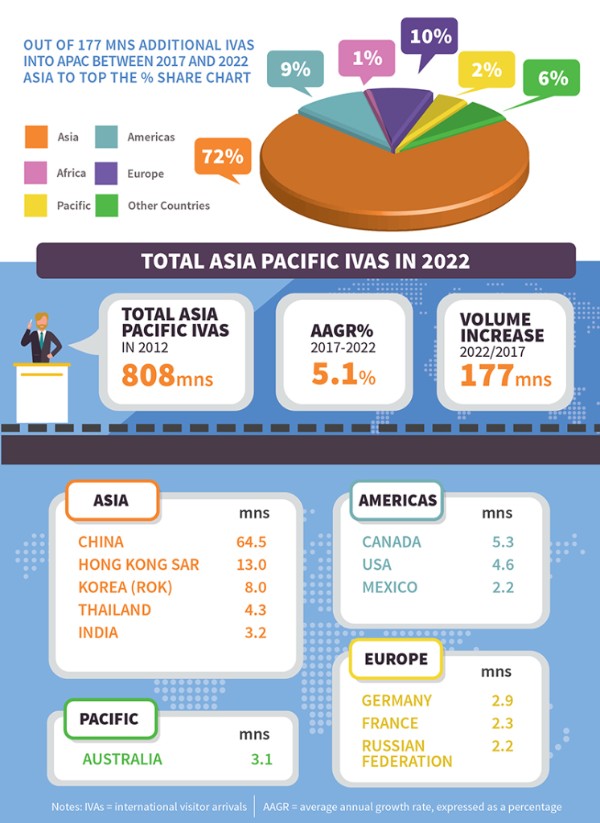
Of the 177 million additional foreign arrivals into Asia Pacific generated between 2017 and 2022, 72% will come from Asian origin markets, 10% from European markets and a little over nine percent will come from origin markets in the Americas.
The strongest Asian market generators of additional visitor arrivals between 2017 and 2022 will be led by China and Hong Kong SAR with respective increases of 64.5 million and 13 million. These will be supported by Korea (ROK), Thailand and India with incremental increases of eight million, 4.3 million and 3.2 million respectively.
Out of Europe, it is expected that the strongest incremental gains in volume of arrivals between 2017 and 2022 will come from Germany, France and the Russian Federation, with increases of 2.9 million, 2.3 million and 2.2 million respectively. Poland (1.9 million additional arrivals) and the United Kingdom (1.5 million additional arrivals) will make up the top five origin markets ranking by incremental increase in the volume of arrivals over that period.
From the Americas, the big three of Canada, the USA and Mexico will generate the most additional volume of arrivals (5.3 million, 4.6 million and 2.2 million) with Argentina and Brazil closing out that top five list with gains of 1.3 million and 0.8 million respectively.
The Pacific also fields a strong supplier of additional foreign arrivals, with Australia producing a period increase of more than 3.1 million, to place it within the top ten list of the strongest generators of incremental volume between 2017 and 2022.
RECEIPTS GROWTH 2017 TO 2018, AND 2017 TO 2022
The tourism-related revenue that these foreign arrivals generate is another useful metric. For the 25 destinations in this report where such data are available, it appears that total receipts from international tourism will increase from US$710 billion in 2017 to more than US$755 billion in 2018 and continue to grow to 2022 when tourism expenditure is expected to reach more than US$955 billion.
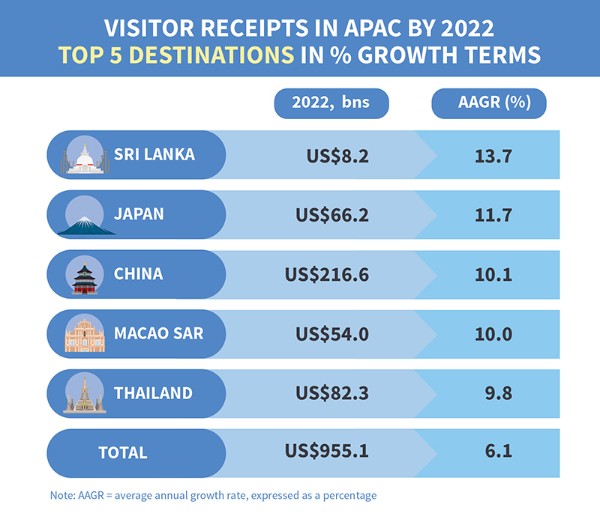
From among these 25 destinations the Americas held a collective 36.1% share of tourism receipts in 2017. That relative performance however, is expected to reduce to 34.7% in 2018 and then fall away to just over 29.1% by 2022 even as receipts will increase by an annual average of 1.7% between 2017 and 2022.
Asia on the other hand, is expected to see its receipts from tourism increase from US$409 billion in 2017 to US$447 billion in 2018, and to almost US$625 billion by 2022. This moves the relative share position of Asia in terms of receipts from international tourism among this group of destinations, from 57.6% in 2017 to 59.2% in 2017 and 65.4% by 2022. The Asian AAGR for tourism receipts between 2017 and 2022 is expected to be around 8.8% with Northeast and South Asia showing even stronger average growth with AAGRS of 9.6% and 9.3% respectively.
This Asian growth will be at the expense of not just the Americas, but also the Pacific region where the relative share position will decline from 6.3% in 2017 to 5.5% in 2022, even while tourism receipts grow at an average of 3.2% per annum over that period.
Said Dr. Mario Hardy, CEO of PATA “The growth momentum of Asia Pacific as both a receiver and a generator of international visitors – not just into Asia Pacific but globally – and the receipts that they generate, is set to continue to at least 2022”.
Dr. Hardy added, “As is always the case, growth in international arrivals across Asia Pacific is often unequal, with subtle changes and shifts occurring as travellers discover new destinations and increasingly turn away from those that do not offer the experiences and memories that they seek and demand or that in themselves are, for whatever reason, seen as unstable and unsafe”.
“It must be recognised that gains in international tourism into destinations and locations, do not always occur by the simple diffusion of generally increasing traveller volumes. Success in this regard requires continuous effort and adaptation in order to deliver the superior service that itself regularly drives the positive experiences as demanded and increasingly expected by a constantly changing traveller profile,” he continued.
“These PATA Asia Pacific Visitor Forecasts for the period 2018 to 2022 can deliver quantifiable insights on how these changes and shifts are expected to play out over the next five years, and do so across a number of metrics. As such they offer a substantive background to anyone making resource allocation decisions in the Asia Pacific tourism sector and should feature in any such decisions,” he concluded.
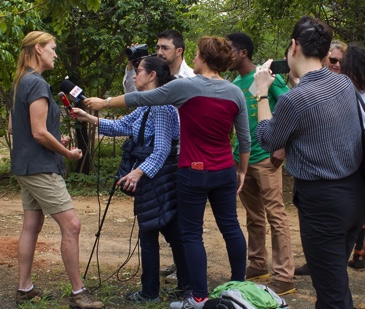
UNWTO/Chimelong Initiative on Wildlife and Tourism launches Media Award
“To engage the media and to recognize the work of journalists in the coverage of wildlife and sustainable tourism.” This is the ultimate goal of the Media Award announced by the World Tourism Organization (UNWTO) on the occasion of Wildlife Day celebrated on 3 March. The UNWTO/Chimelong Initiative aims to promote the value of tourism for wildlife conservation and also includes training to tourism administrations and to media on the theme.
The UNWTO/Chimelong Media Award seeks to recognize the most committed and original purveyors of news and stories related to wildlife conservation and tourism.
“The engagement of media is as important as that of governments and private sector to address the role of tourism as a driver to foster wildlife conservation. Much of our activities in this area are focused in Africa and Asia. The African continent for example is a unique case with regard to wildlife and tourism. Supporting the role of tourism in wildlife conservation is critical for socio-economic development and the achievement of the SDGs and the Agenda 2030 in Africa” said UNWTO Secretary General, Zurab Pololikashvili.
The UNWTO/Chimelong Initiative is being implemented between 2017 and 2019 and aims at engaging key stakeholders like the media and tourism administrations in fostering sustainable tourism as a means to protect wildlife. Seven African countries (Republic of Guinee, Niger, Republic of Congo, Botswana, Benin, Gabon and Democratic Republic of Congo) hosted in 2017 activities of the UNWTO/Chimelong Initiative. Over 100 tourism officers and 50 media professionals have enhanced their capacities and understanding on wildlife through these activities.
A jury of international experts will chose the best piece promoting wildlife and tourism
The Jury of the Media Award is integrated by representatives from UNWTO, the Convention on International Trade in Endangered Species of Wild Fauna and Flora (CITES), UN Environment and Lonely Planet.
John Scanlon, Secretary General of CITES commented “we welcome the initiative of UNWTO on occasion of the World Wildlife Day to highlight the role of the media in raising awareness of how well-managed tourism can support wildlife protection. Journalists can inform and educate the general public, and thereby help generate a positive change in how we view wildlife and sustainable tourism, both within governments and with the private sector”. Scanlon invited journalists worldwide to take part in the competition, “join us in advancing the global cause for wildlife by participating in this years’ Media Award on Wildlife and Sustainable Tourism”, he said.
The role of sustainable tourism in fostering wildlife protection is stressed by Tom Hall, Editorial Director of Lonely Planet and member of the Jury of the UNWTO/Chimelong Media Award. “I’m pleased to be a part of the UNWTO/Chimelong Media Award judging process as the protection of wildlife and advocacy of sustainable tourism is vital to the positive future of travel,” he said.
The Media Award welcomes articles, reports and interviews addressing the topic of wildlife and sustainable tourism published between January 2017 and June 2018 in any of the five UNWTO official languages (English, French, Spanish, Russian and Arabic).
The deadline for submissions is 15th July 2018. The awardee will be designated at the Awards Ceremony that will take place in September 2018.

UNWTO deepens tourism cooperation with the European Union
Advancing sustainable tourism across Europe is at the center of an agreement signed today between the World Tourism Organization (UNWTO) and the European Parliament. During his first official visit to Brussels (27-28 February), UNWTO Secretary-General, Zurab Pololikashvili, met with the President of the European Parliament, Antonio Tajani, the European Commissioner for Internal Market, Industry, Entrepreneurship and SMEs, Elżbieta Bieńkowska as well as the Vice-Chair of the Committee on Transport and Tourism and Responsible for the Tourism Task Force, Istvan Ujhelyi and the representatives of the European Tourism Manifesto. Addressing the Tourism Task Force of the European Parliament Mr. Pololikashvili highlighted the need to enhance integration, connectivity and technology to maximize the role of tourism in creating jobs and stimulating growth in the European Union (EU).
Europe is the world’s leading tourism destination receiving half of the world’s 1.3 billion international arrivals. In 2017, international tourism in Europe grew 8%, one percentage point above the world average, totalling 671 million tourists.
During the signing of the agreement, Mr. Pololikashvili stressed how “the best way to ensure tourism’s positive impact for its people is by working closely with the European Parliament as the representative of the people of Europe”. “Today we are becoming stronger partners in our work to make tourism, and cultural tourism in particular, a driver of prosperity, opportunity, and better livelihoods across the EU”, he added.
UNWTO and the EU Parliament will work on promoting good practices and the sharing of knowledge and experiences on the ground. The agreement coincides with 2018 as the European Year of Cultural Heritage and is an opportunity to highlight the relevance of cultural tourism, which is an outstanding travel asset in the EU countries.
“Over the next 10 years, tourism can create more than 5 million new jobs, not least because the number of tourists is set to double to more than 2 billion. Europe must not let this opportunity pass by. Through the growth of tourism, we can offer real prospects for the new generations and boost strategic sectors of the economy, such as transport, trade, luxury goods, shipbuilding, construction, agri-foodstuffs and the cultural and creative industries” said Antonio Tajani. “We can’t just wait for this to happen by itself. We must work, including with UNWTO, to improve our competitiveness and our skills, to face the challenges of digitalisation and to promote Europe as the world’s number one tourist destination”, he added.
EU tourism and the EU-China Tourism Year
The UNWTO Secretary-General met with the European Commissioner for Internal Market, Industry, Entrepreneurship and SMEs, Elżbieta Bieńkowskaand exchanged views with the members of the Tourism Task Force of the European Parliament and withthe public and private stakeholders assembled around the European Tourism Manifesto.
On the occasion, UNWTO Secretary-General stressed the importance of working in collaboration with the European institutions on key priorities: sustainability; innovation and technology; safety and security; and education and job creation.
Addressing the EU–China Tourism Year Parliamentary Day, which celebrated the EU-China Tourism Year, Mr. Pololikashvili said “This year comes as an opportunity to make Europe the best global destination for Chinese tourists and to use tourism to increase understanding between Europe and China”.
According to the European Travel Commission, 12.4 million Chinese tourists visited the EU in 2017. With an average above one million per month and considering the prospects of growth, the impact of Chinese tourists on EU tourism is relevant factor for European tourism development and bilateral relations with China.
